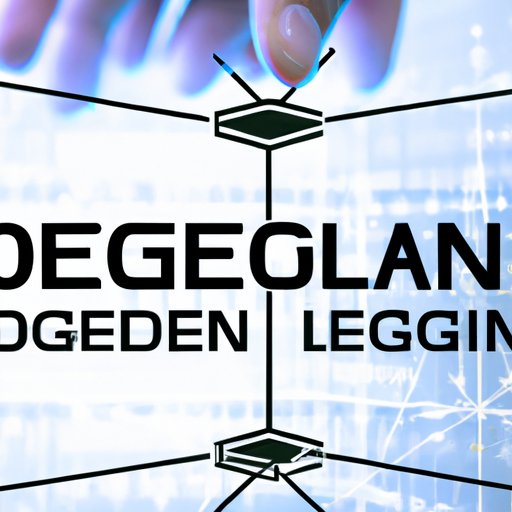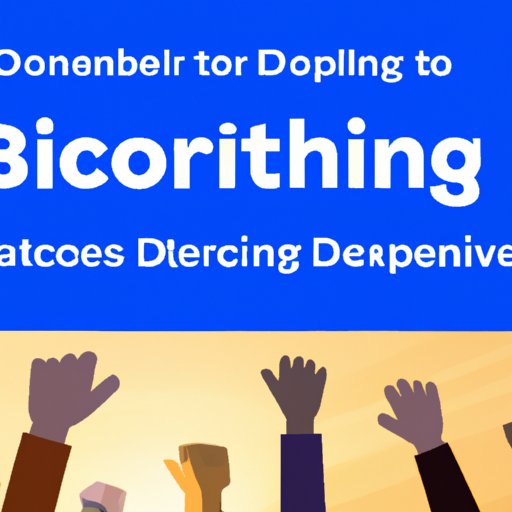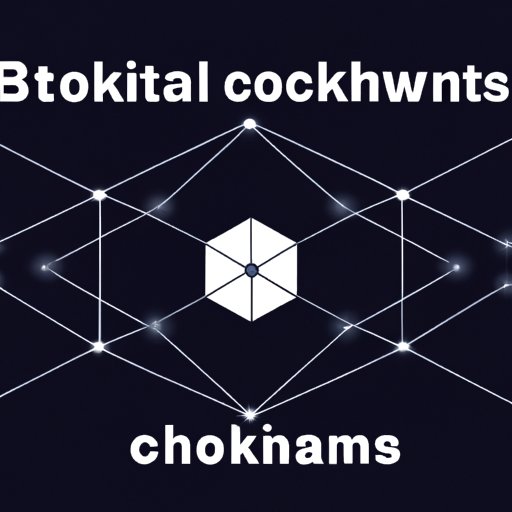Introduction
Blockchain technology has revolutionized the way we think about data security and trust. It is a decentralized digital ledger which records transactions across many computers in a secure and immutable way. With its ability to provide transparency and accountability, blockchain technology has been adopted by various industries such as finance, healthcare, logistics, and more. As the demand for blockchain developers grows, so does the need for individuals who are knowledgeable in this technology.
This article aims to provide a comprehensive guide on how to become a blockchain developer from scratch. We will explore the fundamentals of blockchain technology, the different programming languages used to develop blockchain applications, cryptography and consensus mechanisms, popular development frameworks and tools, distributed ledger technology (DLT) projects, and blockchain developer communities. By the end of this article, you should have a better understanding of the skills required to become a successful blockchain developer.
Researching Blockchain Technology Fundamentals
Before diving into the technical aspects of becoming a blockchain developer, it is important to understand the basics of blockchain technology. This includes understanding what blockchain technology is and how it works. Additionally, familiarizing yourself with key concepts, terminology, and principles related to blockchain technology is essential.
What is blockchain technology?
Blockchain technology is a revolutionary new way of storing and managing data. It is a digital ledger that is distributed across multiple computers in a secure and immutable way. All data stored on the blockchain is encrypted and can only be accessed by authorized users. The data is also tamper-proof, meaning that once a transaction is recorded on the blockchain, it cannot be changed or altered in any way.
How does it work?
The blockchain works by creating a “chain” of blocks that contain data. Each block is linked to the previous one, creating an unalterable chain of records. When a new block is created, it is added to the chain and all other users on the network are notified. Transactions are verified by miners, who work to solve complex mathematical problems in order to verify the authenticity of the transaction. Once a transaction is verified, it is added to the blockchain and can never be changed or removed.
Understanding key concepts, terminology and principles
In order to become a successful blockchain developer, it is important to understand the key concepts, terminology, and principles related to blockchain technology. These include understanding the difference between public and private blockchains, the concept of decentralization, consensus mechanisms, smart contracts, and more. Understanding these concepts will enable you to develop more secure and reliable blockchain applications.
Learning Programming Languages
After gaining a basic understanding of blockchain technology, the next step is to learn the programming languages used to develop blockchain applications. Different programming languages can be used depending on the type of application being developed. Popular programming languages used for blockchain development include Python, C++, and Solidity.
Python
Python is a high-level programming language that is widely used for general purpose programming. It is a great choice for blockchain development due to its readability, flexibility, and scalability. Python is easy to learn and is often used to create simple blockchain applications such as wallets and cryptocurrency exchanges.
C++
C++ is a powerful programming language that is used to develop high-performance blockchain applications. It is a low-level language which allows developers to have more control over the code they write. C++ is often used to develop cryptocurrency wallets, smart contracts, and blockchain networks.
Solidity
Solidity is a high-level programming language specifically designed for developing smart contracts. It is based on JavaScript and is used for creating decentralized applications (DApps) on the Ethereum blockchain. Smart contracts are self-executing contracts which are used to automate processes and facilitate transactions on the blockchain.

Understanding Cryptography and Consensus Mechanisms
Cryptography and consensus mechanisms are two essential components of blockchain technology. In order to become a successful blockchain developer, it is important to understand how these two technologies work and how they are used to ensure data security and integrity.
What is cryptography?
Cryptography is the practice of using algorithms to encrypt and decrypt data. Cryptography is used to secure data stored on the blockchain and to prevent unauthorized access. It is an essential part of blockchain technology as it ensures that data is kept safe and secure.
What are consensus mechanisms?
Consensus mechanisms are algorithms that are used to validate transactions on the blockchain. They are used to ensure that all nodes on the network agree on the state of the blockchain and to prevent malicious actors from tampering with the data. Examples of popular consensus mechanisms include proof of work (POW), proof of stake (POS), and delegated proof of stake (DPOS).
Familiarizing Yourself with Popular Frameworks and Development Tools
Once you have a basic understanding of blockchain technology and the necessary programming languages, the next step is to familiarize yourself with popular frameworks and development tools. There are many frameworks and development tools available for building blockchain applications, each with their own advantages and disadvantages.
What frameworks and development tools are available?
Popular frameworks and development tools for blockchain development include Hyperledger Fabric, Ethereum, Eris, Multichain, BigchainDB, and Chain Core. Each of these frameworks and tools offer different features and capabilities and can be used to build different types of applications.
Benefits of using popular frameworks
Using popular frameworks and development tools can save you time and effort as they provide pre-built modules and libraries which can be used to quickly build applications. Frameworks also make it easier to deploy applications on the blockchain and can help reduce development costs. Additionally, most frameworks come with built-in security features which help protect applications from malicious attacks.
Tips for choosing the right framework
Choosing the right framework for your project depends on the type of application you are building. For example, if you are building a cryptocurrency wallet, you may want to use a framework such as Ethereum or Eris. If you are building a distributed database, you may want to use a framework such as Hyperledger Fabric or BigchainDB. It is important to do research and compare the different frameworks to find the best one for your project.

Gaining Experience with Distributed Ledger Technology
Once you have familiarized yourself with popular frameworks and development tools, the next step is to gain experience with distributed ledger technology (DLT). DLT is the underlying technology behind blockchain and is used to store and manage data on the blockchain. Gaining experience with DLT will give you a better understanding of how blockchain works and will help you develop more secure and reliable applications.
What is distributed ledger technology?
Distributed ledger technology (DLT) is the underlying technology behind blockchain. It is a decentralized database which stores and manages data in a secure and immutable way. DLT enables users to share data without having to rely on a central authority and makes it difficult for malicious actors to manipulate the data.
How to get hands-on experience with DLT
One of the best ways to gain experience with DLT is to join a blockchain developer community. Communities provide an excellent platform to share knowledge and collaborate on projects. You can also take online courses which cover topics such as blockchain fundamentals, cryptography, and consensus mechanisms. Additionally, there are many open source projects which you can contribute to and learn from.
Examples of DLT projects
Some popular DLT projects include Bitcoin, Ethereum, Hyperledger Fabric, Eris, Multichain, and BigchainDB. Each of these projects offers a different set of features and capabilities and can be used to build different types of applications. Contributing to open source projects is a great way to gain experience with DLT and to sharpen your skills as a blockchain developer.

Joining a Blockchain Developer Community
Finally, joining a blockchain developer community is a great way to stay up-to-date on the latest developments in blockchain technology and to make valuable connections. Communities provide a platform to share knowledge, collaborate on projects, and discuss ideas with like-minded individuals.
What is a blockchain developer community?
A blockchain developer community is a group of people who are passionate about blockchain technology and are dedicated to learning and developing the technology. Communities provide an excellent platform for sharing knowledge and collaborating on projects. They also provide opportunities to meet other blockchain developers and make valuable connections.
Benefits of joining a community
Joining a blockchain developer community provides many benefits. You can stay up-to-date on the latest advancements in blockchain technology and learn from experienced developers. Additionally, communities provide an opportunity to make valuable connections and to collaborate on projects with like-minded individuals.
Finding and joining a blockchain developer community
There are many blockchain developer communities available online. Some popular ones include the Ethereum Stack Exchange, the Hyperledger Project, and the Bitcoin Forum. To find and join a community, simply search for “blockchain developer communities” or “blockchain development forums” and join one that interests you.
Conclusion
Becoming a blockchain developer requires a deep understanding of blockchain technology, programming languages, cryptography, consensus mechanisms, frameworks, DLT projects, and blockchain developer communities. Researching blockchain technology fundamentals and learning the necessary programming languages are essential steps to becoming a successful blockchain developer. Additionally, familiarizing yourself with popular frameworks and development tools and gaining experience with DLT projects can help you develop more secure and reliable applications. Finally, joining a blockchain developer community is a great way to stay up-to-date on the latest developments in blockchain technology and to make valuable connections.
(Note: Is this article not meeting your expectations? Do you have knowledge or insights to share? Unlock new opportunities and expand your reach by joining our authors team. Click Registration to join us and share your expertise with our readers.)
